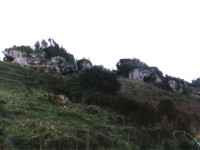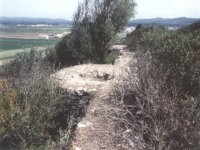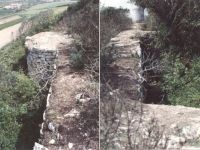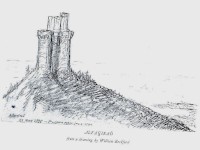Background
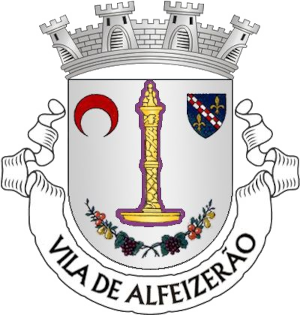
Although in need of in-depth research, the primitive occupation of this coastal region dates back to prehistoric times. For a long time it was admitted (and many wrote so) that the Gallo-Celtic Eburobrittium was located here, which in Roman times was called Eburobritium (in Latin: Eburobritium). This hypothesis was discarded in 1995, with the discovery of the Roman Eburobrício near Óbidos.
It seems likely, however, due to some archaeological findings and remains, and also, interpreting the geographer Ptolemy, that Araducta was located near Alfeizerão. This thesis is defended by Prof. Vasco Gil Mantas, from the University of Coimbra.
The medieval castle

Based on the toponym and references to the castle, it is customary to attribute the founding of Alfeizerão to the Muslims in the 8th century. In our days, however, Prof. Moisés Espírito Santo, from the Universidade Nova de Lisboa, put the date of the foundation back to the time of the Phoenicians, arguing that the toponym has its origins in the Punic dialects that, according to him, the Lusitanians spoke.
In the context of the Christian À época da Reconquest of the Iberian Peninsula, the region was taken in 1147 by the forces of Afonso I of Portugal (1112-1185), who ordered its reconstruction, aiming to defend the stretch of the Atlantic coast between the promontory of Nazaré and the peninsula of Peniche.
The oldest document, known to date, in which the place name appears is a letter of donation dated 1287: They donate from the things that enter the port of Selir to Queen Dona Ysabel certain things (…). Dante and the Alfeysara. IX days of Juynho.
The town received a Charter in 1332, given by the Abbey of Alcobaça and the abbot D. João Martins. This charter was confirmed in 1422 by Abbot Fernão do Quental (or Fernando Quental), and again confirmed in 1514 by King D. Manuel (1495-1521).
From the 1755 earthquake to the present
day

Progressively silted up, at the end of the 16th century it was estimated that this port accommodated eighty large ships. The castle, where sovereigns used to stay on their way to Alcobaça, was partially destroyed by the 1755 earthquake, and has lost its importance ever since.
The castle and its domains remained in the possession of the Abbey of Alcobaça until the abolition of the Religious Orders by D. Maria II (1826-1828; 1834-1853) in 1834, when they passed into the possession of the National Treasury. The castle land has since been in the possession of private individuals from Rio Maior and Caldas da Rainha. In the 20th century, from the 1920s to the 1970s, it was owned by Dr. Júlio Ferrari. Since then, it has been in the possession of a family from Alfeizerão.
In 1973, a proposal was made to clean and consolidate the ruins, with archaeological surveys of the site, classified as a Property of Public Interest by Order of 9 December 1974. However, the work has not taken place since then, and so, year after year, the state of conservation of the site has worsened - with what remains barely visible.
Features
The castle had a rectangular plan, in Romanesque style. Its walls, made of stone masonry, were originally reinforced by eight semi-circular cubes. In the parade ground, off-center to the East, stood the Keep Tower, with a square plan.
The lower part of a section of wall, connecting the remains of two Turrets, has survived to this day. A modern geodetic marker is placed on one of them.
Events of the time
1147 - Start of the Second Crusade.
- Taking of Santarém by Afonso I of Portugal.
- Coming from the English port of Dartmouth, a fleet of 200
sails with crusaders enters the Douro river bar.
- At the proposal of Afonso I of Portugal, the English crusader fleet
begins the Siege of
Lisbon.
After 5 months, Lisbon was conquered from the Moors by the troops of Afonso I of
Portugal.
1148 - Alenquer was conquered from the Moors on June 24th.
- Restoration of the dioceses of Lisbon, Viseu and Lamego by D.
Afonso Henriques.
1151 - The first insurance policy against fire and the effects of the Black Death issued in
Iceland.
- Afonso I of Portugal tries,
in vain, to take Alcácer do Sal.
1153 - Foundation of the Cistercian abbey of
Alcobaça.
S
1158 - The Pound Sterling becomes the currency of England.
- June 24 - Conquest of Alcácer do Sal.
1158 - The Pound Sterling becomes the currency of England.
- June 24 - Conquest of Alcácer do Sal.
- May 22 - In Sahagún,
Fernando II
of
León and Sancho III of Castile
agree
to join their efforts to subdue Afonso I of Portugal.
1159 - Donation of the Wax Castle to Gualdim Pais.
- December 22 - Afonso I of Portugal meets in the town of Santa
Maria de Palo with King Fernando II of León, to
resolve the issue of border demarcations of the Portuguese and Leonine reconquests.
